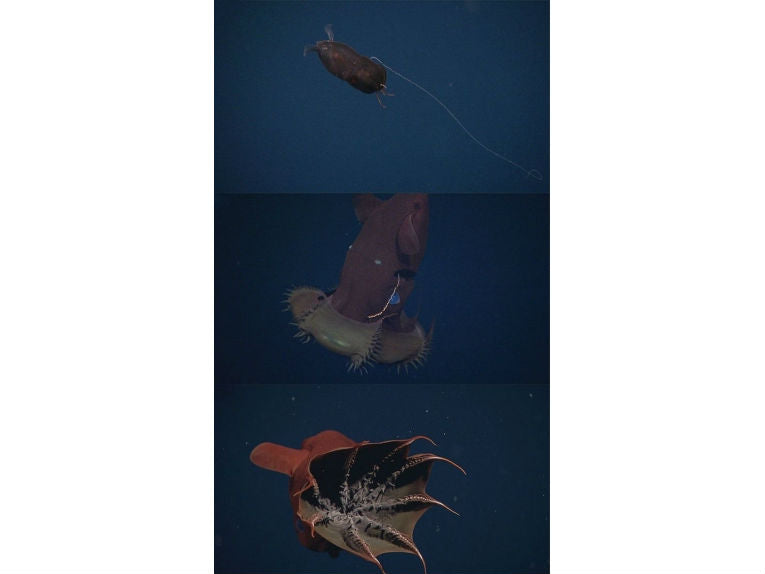Above: These unique cephalopods are neither octopus nor squid. They are named because of their dark colours with bioluminescent displays
(a) A juvenile Vampyroteuthis with its filament extended, the short peduncle is visible at the base of the filament.
(b) A vampire squid with a retrieved filament and the web partly curled, revealing the arms and cirri.
(c) Oral view into the vampire squid's web showing the arms with cirri and the suckers present on the distal half of the arm
The little-known but well-recorded (usually with horror) vampire "squid" is in fact the sole, relic descendant of a special cephalopod group. They live in the science-fiction-sounding OMZ. This is simply the deep ocean zone where the oxygen finally becomes almost non-existent. With the biggest eyes in the world for its size and every possible gill and blood modification, the Vampyroteuthis is one of the wonders of the fauna of the deep! It needs all those respiratory adaptations because of the low percentage of oxygen deep down at 600-900 metres.
While squid and octopus are predacious in all the niches they occupy from coast to the abyss, they have a variety of ambush techniques and engulfment as well as jet-speed, in the case of fish-catching squid. Only the vampire "squid" lacks feeding tentacles though. It has instead two often unnoticed retractile filaments, modified possibly from the two extra arms of the decapods squid. Instead of feeding tentacles, the vampire has its tentacles joined in a sinister web-like structure. Inside it blue light is transmitted. One of the lights' functions is to distract predators below the animal that would be able to view its dark shape against the twilight view of the sky, hundreds of metres above. The bioluminescent display could have many other uses for both attraction or repulsion.
Apparently, the Vampyromorpha group, of which this is the only one, are a sister group to the octopoda, rather than the squid (decapoda), being found everywhere in temperate and tropical waters with dissolved oxygen of 13-16%( around 0.4ml l-1 ), on the hypoxic edge of animal life.
According to the new paper, published today by Monterey Bay's Aquarium research Institute in California, the creature moves lethargically because of its limited oxygen (and food also, it seems). Some researchers have been shocked to see the Vampyroteuthis shooting along and flashing its lights, but perhaps the animals' own shock at seeing undersea vehicles could cause it to panic! The dark forbidding colour of the animals is unlike the typical octopus that can change colour, so its feeding could be totally different. Diatoms, prawn, cnidarians and what is called marine "snow" seem to be associated with mucus on its retractile tentacles.
Over 20 years, Hendrik J. T. Hoving and Bruce H. Robison from the Institute have observed the feeding and found no evidence of predated animals. The food seemed to consist of faeces, copepod (shrimp) parts, diatoms and fish scales, usually in mucus. As these have an average organic carbon content of 5.4mg per gram, this would serve as quite nutritious, given the barren environment. Motionless animals were often discovered when the researchers went down to the depths. One filament extended, with stiff hairs enabling it to trap any particles and drag them with mucus onto the tentacles. Sensory cells were frequent on the arms such that food signals to the brain would be swift. Once in the large crop, the dilute food could be mixed with tiny live food. This has occasionally been seen caught within the large web (of the tentacles.) As a detrivore the species takes advantage of the lack of predators in the OMZ and the abundant nutrient rich food drifting down to it. Extremely low metabolic rates are the lowest known in any cephalopod, actually making it very successful within this specialised niche.
The full paper, Vampire Squid: Detritivores In The Oxygen Minimum Zone, has been published today in the Proceedings of the Royal Society B: Biological Sciences.

Credit: © Proceedings of the Royal Society B: Biological Sciences
Above:
(a) An oral view of Vampyroteuthis infernalis.
(b) A marine aggregate in the mouth of vampire squid.
(c) A dorso-lateral close-up of the left side of the head of a vampire squid, showing the filament being retracted, a mucus trail is visible on the filament.
(d) An oral view of a vampire squid showing a trail of mucus with associated food particles running to the mouth.
(e) A vampire squid with a forward-extended filament and a piece of marine snow on the tip of the second right arm.
(f) The same specimen shown as in (e) now retrieving the filament along the tips of its arms










